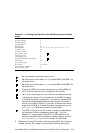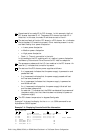
• Shared storage that is connected to KZPBA-CB (parallel SCSI) or
KGPSA-CA (Fibre Channel) host bus adapters.
• Network controllers.
3. Install BN39B cables between the local I/O risers on the QBBs in the
partition (see Figure 7–1) and the remote I/O risers in the primary and
expansion PCI drawer (see Figure 2–1 and Figure 7–3). Use BN39B-01
cables (1-meter) for a PCI drawer in the GS80 RETMA cabinet. Use
BN39B-04 cables (4-meter) if the PCI drawer is in a GS160 or GS320
power cabinet. Use BN39B-10 cables (10-meter) if the PCI drawer is in
an expansion cabinet. Ensure that you connect the cables to the
0-R
and 1-R (remote I/O riser) connections in the PCI drawer and not to a
Memory Channel module.
____________________ Note _____________________
We recommend that you connect I/O riser 0 (local I/O riser
ports 0 and 1) to the primary PCI drawer that will be the
master system control manager (SCM).
If you require more than two PCI drawers in a hard partition, you need
more than one QBB in the partition. Each QBB supports two PCI
drawers (2 cables between a local I/O riser and a PCI drawer).
4. Set the PCI drawer node ID with the pushbutton up-down counter
on the CSB node ID module at the rear of each PCI drawer (see
Figure 7–3). Set the node ID of the primary PCI drawer with the master
SCM to zero. Set the node ID of the primary PCI drawer with the
standby SCM (if applicable) to one. Increment the PCI drawer node ID
for successive PCI drawers.
5. Ensure that the primary PCI drawer that contains the master SCM
is connected to the OCP. Connect the primary PCI drawer with the
standby SCM (if applicable) to the OCP.
6. Connect an H8585-AA connector to the terminal port on the standard
I/O module for the new partition. Connect a BN25G-07 cable between
the H8585-AA connector and the terminal server to provide the console
terminal connection to the system management console.
Use the system management console terminal emulator to create a new
terminal window for the partition.
7. Turn on the AC circuit breakers for each of the QBBs. Doing so provides
power to the console serial bus (CSB) and SCM. Do not turn on the
OCP key switch; you do not have to go through the lengthy power-up
sequence to partition the system.
Using GS80, GS160, or GS320 Hard Partitions in a TruCluster Server Configuration 7–9


















